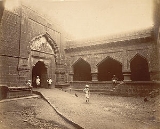
Panhala fort
Encyclopedia
Panhala fort also known as Panhalgad, Pahalla and Panalla (literally "the home of serpents"), is located in Panhala
, 20 kilometres northwest of Kolhapur in Maharashtra
, India
. It is strategically located looking over a pass in the Sahyadri mountain range which was a major trade route from Bijapur
in the interior of Maharashtra to the coastal areas. Due to its strategic location, it was the centre of several skirmishes in the Deccan involving the Marathas
, the Mughals
and the British East India Company
, the most notable being the Battle of Pavan Khind
. Here, the queen regent of Kolhapur, Tarabai
, spent her formative years. Several parts of the fort and the structures within are still intact.

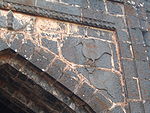 Panhala fort was built between 1178 and 1209 CE, one of 15 forts (others including Bavda, Bhudargad
Panhala fort was built between 1178 and 1209 CE, one of 15 forts (others including Bavda, Bhudargad
, Satara, and Vishalgad
) built by the Shilahara
ruler Bhoja II
. A copper plate found in Satara shows that Raja Bhoja held court at Panhala from 1191–1192 CE. About 1209–10, Bhoja Raja was defeated by Singhana (1209–1247), the most powerful of the Devgiri Yadavas, and the fort subsequently passed into the hands of the Yadavas. Apparently it was not well looked after and it passed through several local chiefs. In 1376 inscriptions record the settlement of Nabhapur to the south-east of the fort.
It was an outpost of the Bahamanis
of Bidar
. Mahmud Gawan, an influential prime minister, encamped here during the rainy season of 1469. On the establishment of the Adil Shahi dynasty of Bijapur in 1489, Panhala came under Bijapur and was fortified extensively. They built the strong ramparts and gateways of the fort which, according to tradition, took a hundred years to build. Numerous inscriptions in the fort refer to the reign of Ibrahim Adil Shah, probably Ibrahim I (1534–1557).

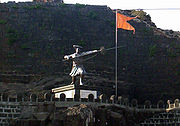 In 1659, after the death the Bijapur general Afzul Khan
In 1659, after the death the Bijapur general Afzul Khan
, in the ensuing confusion Shivaji took Panhala from Bijapur. In May 1660, to win back the fort from Shivaji, Adil Shah II (1656–1672) of Bijapur sent his army under the command of Siddi Johar to lay siege to Panhala. Shivaji fought back and they could not take the fort. The siege continued for 4 months, at the end of which all provisions in the fort were exhausted and Shivaji was on the verge of being captured.
Under these circumstances, Shivaji decided that escape was the only option. He gathered a small number of soldiers along with his trusted commander Baji Prabhu Deshpande
and, on 13 July 1660, they escaped in the dead of night to flee to Vishalgad. Baji Prabhu and a barber, Shiva Kashid, who looked like Shivaji, kept the enemy engaged, giving them an impression that Shiva Kashid was actually Shivaji. In the ensuing battle (see Battle of Pavan Khind
), almost three quarters of the one thousand strong force died, including Baji Prabhu himself. The fort went to Adil Shah. It was not until 1673 that Shivaji could occupy it permanently.
Sambhaji
, Shivaji's son and successor to the throne, fell out of favor with his father. Shivaji imprisoned Sambhaji in Panhala fort. He escaped from here along with his wife on 13 December 1678 and attacked Bhupalgad. He returned to Panhala, however, on 4 December 1679 to reconcile with his father just before his father's death on 4 April 1680. At the height of Shivaji's power in 1678, Panhala housed 15,000 horses and 20,000 soldiers.
 When Shivaji died, Sambhaji was able to convince the garrison at Panhala to join him in overthrowing his stepbrother Rajaram, thus becoming the Chhatrapati
When Shivaji died, Sambhaji was able to convince the garrison at Panhala to join him in overthrowing his stepbrother Rajaram, thus becoming the Chhatrapati
(king) of the Maratha Empire. In 1689, when Sambhaji was imprisoned by Aurangzeb's general Takrib Khan at Sangameshwar, the Mughals came to possess the fort. However, it was re-captured in 1692 by Kashi Ranganath Sarpotdar under the guidance of Parshuram Pant Pratinidhi a Maratha garrison commander of the fort of Vishalgad
. In 1701 Panhala finally surrendered to Aurangzeb, who came for it in person. On 28 April 1692 the Mughal Emperor famously received the English ambassador Sir William Norris
at Panhala fort. Norris spent "300 pounds in fruitless negotiation" with Aurangzeb but the details of what was being discussed was not disclosed. Within a few months the fort was retaken by the Maratha forces under Ramchandra Pant Amatya
.
In 1693, Aurangzeb attacked it again. This led to another long siege in which Rajaram escaped disguised as a beggar to Gingee Fort
, leaving his 14-year-old wife Tarabai
in Panhala. As Aurangzeb pursued Rajaram, Tarabai would stay at Panhala for almost five years before meeting her husband again. During this formative period of her life, Tarabai looked after the administration of the fort, resolved disputes and gained the respect of the people. The time she spent at Panhala provided her with experience in courtly matters and the support of her officers, which would influence later events. Rajaram did send reinforcements from Gingee, and Panhala came into Maratha hands in October 1693.
In 1700, Rajaram, died leaving behind a 12-year-old son—Shivaji II—by his wife Tarabai
. In 1705, Tarabai
asserted her autonomy by founding an independent dynasty in the name of her son Shivaji II and ruling it as regent with Panhala as her headquarters. In Tarabai's war with Shahuji
of Satara in 1708, Shahu took Panhala and Tarabai fled to Malvan
in Ratnagiri. Shortly after, in 1709, Tarabai again took Panhala, established a separate state (Kolhapur) and made Panhala the capital. This it would remain till 1782.
After the death of Tarabai, Sambhaji II, the son of Rajaram by his second wife Rajasbai succeeded to the throne. He died without issue in 1760. His widow Jijabai adopted the son of a Sahaji Bhonsle of Kanvat. Thus, Jijabai became the acting regent during the time that her adopted son was a minor. She came to believe that to prevent the fall of Panhala, the Mahakali shrine at the fort had to be ritually offered human blood for the appeasement of Goddess Kali. She would periodically send out her soldiers at night to scour the neighboring villages for victims. This practice would continue until her death in 1772. One of the towers near where these sacrifices occurred is still called the Kali tower. There were reports of Jijabai bestowing a plot of land to an oilman or Teli
in return for the grant of his daughter-in-law to be buried alive under one of the Panhala towers. A shrine to the Teli's daughter-in-law (Gangubai) was subsequently erected and it is still a pilgrimage site for the people of the Teli community.
In 1782, the seat of the Kolhapur government was moved from Panhala to Kolhapur. In 1827, under Shahoji I (1821–1837), Panhala and its neighboring fort Pavangad
were given over to the British Raj
. In 1844, during the minority of Shivaji IV
(1837–1860), Panhala and Pavangad were taken by rebels who seized Colonel Ovans, the Resident of Satara, when he was on tour and imprisoned him in Panhala. A British force under General Delamotte was sent against the rebels and on 1 December 1844 breached the fort wall, took it by storm, and dismantled the fortifications. Thereafter, a British garrison was always left to guard the fort. The administration of the fort remained with Kolhapur until 1947.
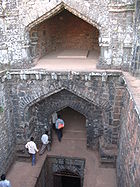 It is one of the largest forts in the Deccan, with a perimeter of 14 km (9 mi) and 110 lookout posts. It is 845 m (2,772 ft) above sea level. This fort is built on the Sahyadris
It is one of the largest forts in the Deccan, with a perimeter of 14 km (9 mi) and 110 lookout posts. It is 845 m (2,772 ft) above sea level. This fort is built on the Sahyadris
, rising more than 400 m (1,312 ft) above its surrounding plain. Numerous underground tunnels stretch out from underneath the fort, one of which is almost 1 km long. Most of the architecture is of the Bijapuri style with the peacock motif of the Bahmani Sultanate prominently visible on several structures. Some of the older bastions also have the lotus motif of Bhoja II. There are several monuments at the fort which are considered notable by the Archaeological Survey of India
.
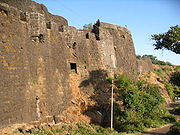
_panhala.jpg) The name of this building, which is also called Nayakini Sajja, literally means "Courtesans' Terrace room". It stands on the east side of the fort close to the rampart. By 1886, it had become a complete wreck with only traces of ornamental work on the ceiling. This was used during the occupation of the fort by the Bahmani Sultanate as a Rang Mahal(residences for the ladies of the court)
The name of this building, which is also called Nayakini Sajja, literally means "Courtesans' Terrace room". It stands on the east side of the fort close to the rampart. By 1886, it had become a complete wreck with only traces of ornamental work on the ceiling. This was used during the occupation of the fort by the Bahmani Sultanate as a Rang Mahal(residences for the ladies of the court)
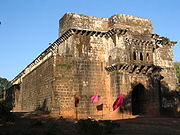
and warai were the major provisions stored. Stairs on both sides lead the top of the buildings. It has sixteen bays each with its own flat vault with a hole on top through which grain used to be passed. The eastern entrace has a domed chamber with a balconey and plasterwork of the Bijapuri style.


s with the balconies hanging over the ramparts of the fort. This is where Shivaji imprisoned his son, Sambhaji, when he threatened to defect to Aurangzeb.
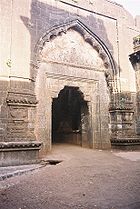
. The outer gate has a ornate chamber on top with decorated eaves
. The inner gate from the court is highly decorated with the lintel having finely carved motifs, including one of Ganesh. The latter has been placed by the Marathas during their occupation of the fort. There are three Persian inscriptions—one on top and one each on either side. All three declare that the gate "was built in the reign of Ibrahim Adil Shah I by Malik Daud Aki son of Minister Ahmed" in 954 AH
(1534 CE).
during the Battle of Pavan Khind
. Rajdindi is still intact.
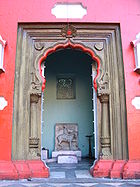 There are temples devoted to Sambhaji II, Someshwar and Ambabai in addition to the Mahakali temple. The Ambabai temple is very old and it was here that Shivaji would make offerings before embarking on major expeditions. The mausoleum of Jijabai lies opposite toto that of her husband, Sambhaji II. Ramchandra Pant Amatya
There are temples devoted to Sambhaji II, Someshwar and Ambabai in addition to the Mahakali temple. The Ambabai temple is very old and it was here that Shivaji would make offerings before embarking on major expeditions. The mausoleum of Jijabai lies opposite toto that of her husband, Sambhaji II. Ramchandra Pant Amatya
(who wrote Adnyapatra
, a treatise on Maratha policy) was the youngest minister in Shivaji's fort. He died at Panhala fort and a mausoleum was erected here for him and his wife. The mausoleums were covered with rubble till 1941 and till 1999 had not undergone any restoration work. Also a mausoleum to Moropant
an 18th century Marathi poet who wrote poetry in the adjacent Parashar caves can be seen. A shrine to a Muslim saint Sadhoba is also present.
, arguably the fort's most famous resident, is still intact. It is now used to house a school, several government offices and a boys' hostel. The rest of the fort is in ruins though the structures within the fort are frequented by tourists who visit Panhala town- a major hill station.
Panhala
Panhala is a city and a Hill station Municipal Council 18 km northwest of Kolhapur, in Kolhapur district in the Indian state of Maharashtra. Panhala is the smallest city in Maharastra and being a Municipal Council the city is developing rapidly. The city sprawls in the Panhala fort commands...
, 20 kilometres northwest of Kolhapur in Maharashtra
Maharashtra
Maharashtra is a state located in India. It is the second most populous after Uttar Pradesh and third largest state by area in India...
, India
India
India , officially the Republic of India , is a country in South Asia. It is the seventh-largest country by geographical area, the second-most populous country with over 1.2 billion people, and the most populous democracy in the world...
. It is strategically located looking over a pass in the Sahyadri mountain range which was a major trade route from Bijapur
Bijapur, Karnataka
Bijapur Urdu:بیجاپور city is the district headquarters of Bijapur District of Karnataka state. Bijapur city is well known for its historical monuments of architectural importance built during the rule of Adil Shahi dynasty...
in the interior of Maharashtra to the coastal areas. Due to its strategic location, it was the centre of several skirmishes in the Deccan involving the Marathas
Maratha Empire
The Maratha Empire or the Maratha Confederacy was an Indian imperial power that existed from 1674 to 1818. At its peak, the empire covered much of South Asia, encompassing a territory of over 2.8 million km²....
, the Mughals
Mughal Empire
The Mughal Empire , or Mogul Empire in traditional English usage, was an imperial power from the Indian Subcontinent. The Mughal emperors were descendants of the Timurids...
and the British East India Company
East India Company
The East India Company was an early English joint-stock company that was formed initially for pursuing trade with the East Indies, but that ended up trading mainly with the Indian subcontinent and China...
, the most notable being the Battle of Pavan Khind
Battle of Pavan Khind
Battle of Pävankhind was a rear guard battle and a Last Stand that took place on July 13, 1660 at a mountain pass in the vicinity of fort Vishalgad, near the city of Kolhapur, Maharashtra, India between the Maratha sardar Baji Prabhu Deshpande and Siddi Masud of Adilshah. The Marathas held the...
. Here, the queen regent of Kolhapur, Tarabai
Tarabai
Tarabai was a queen of the Maratha Empire in India. Her husband was Chhatrapati Rajaram, son of Shivaji. Tarabai was the daughter of the famed Maratha general Hambirao Mohite...
, spent her formative years. Several parts of the fort and the structures within are still intact.
History


Bhudargad
Bhudargad is a tehsil in Radhanagari subdivision of Kolhapur district in the Indian state of Maharashtra.Bhudargad is a taluka in Kolhapur district. It comes under Radhanagari subdivision.Gargoti is the headquarter of Bhudargad taluka...
, Satara, and Vishalgad
Vishalgad
Vishalgad was one of the important forts of Shivaji and Maratha Empire. The name ‘Vishalgad’ meaning grand fort in Marathi, was given by Shivaji after annexing it for the Maratha Empire in 1659.The fort is about 1130 meters that is 3630 feet.-Origin of the name Vishalgad:Khelna was in the control...
) built by the Shilahara
Shilahara
The Shilahara Dynasty was a feudal clan that established itself in northern and southern Konkan and southern Maharashtra during the Rashtrakuta period...
ruler Bhoja II
Bhoja II
Bhoja II was a ruler in medieval India, the last of the Shilahara dynasty of Kolhapur in Maharashtra. He suffered a crushing defeat at the hands of Singhana, king of the Yadava Dynasty, in 1212 CE at Umalvad...
. A copper plate found in Satara shows that Raja Bhoja held court at Panhala from 1191–1192 CE. About 1209–10, Bhoja Raja was defeated by Singhana (1209–1247), the most powerful of the Devgiri Yadavas, and the fort subsequently passed into the hands of the Yadavas. Apparently it was not well looked after and it passed through several local chiefs. In 1376 inscriptions record the settlement of Nabhapur to the south-east of the fort.
It was an outpost of the Bahamanis
Bahmani Sultanate
The Bahmani Sultanate was a Muslim state of the Deccan in southern India and one of the great medieval Indian kingdoms...
of Bidar
Bidar
Bidar is a city in the Indian state of Karnataka. Located on the Deccan Plateau in the north-eastern part of Karnataka. It is the headquarters of the Bidar District....
. Mahmud Gawan, an influential prime minister, encamped here during the rainy season of 1469. On the establishment of the Adil Shahi dynasty of Bijapur in 1489, Panhala came under Bijapur and was fortified extensively. They built the strong ramparts and gateways of the fort which, according to tradition, took a hundred years to build. Numerous inscriptions in the fort refer to the reign of Ibrahim Adil Shah, probably Ibrahim I (1534–1557).
Under Shivaji


Afzul Khan
Afzal Khan was a medieval Indian commander who served the Adil Shahi dynasty of Bijapur, and fought against the Marathas...
, in the ensuing confusion Shivaji took Panhala from Bijapur. In May 1660, to win back the fort from Shivaji, Adil Shah II (1656–1672) of Bijapur sent his army under the command of Siddi Johar to lay siege to Panhala. Shivaji fought back and they could not take the fort. The siege continued for 4 months, at the end of which all provisions in the fort were exhausted and Shivaji was on the verge of being captured.
Under these circumstances, Shivaji decided that escape was the only option. He gathered a small number of soldiers along with his trusted commander Baji Prabhu Deshpande
Baji Prabhu Deshpande
Baji Prabhu Deshpande was one of the lieutenants of Chattrapati Shivaji, founder of the Maratha empire...
and, on 13 July 1660, they escaped in the dead of night to flee to Vishalgad. Baji Prabhu and a barber, Shiva Kashid, who looked like Shivaji, kept the enemy engaged, giving them an impression that Shiva Kashid was actually Shivaji. In the ensuing battle (see Battle of Pavan Khind
Battle of Pavan Khind
Battle of Pävankhind was a rear guard battle and a Last Stand that took place on July 13, 1660 at a mountain pass in the vicinity of fort Vishalgad, near the city of Kolhapur, Maharashtra, India between the Maratha sardar Baji Prabhu Deshpande and Siddi Masud of Adilshah. The Marathas held the...
), almost three quarters of the one thousand strong force died, including Baji Prabhu himself. The fort went to Adil Shah. It was not until 1673 that Shivaji could occupy it permanently.
Sambhaji
Sambhaji
Sambhaji Raje Bhosle was the eldest son and successor to Emporer Shivaji, the founder of the Maratha empire.- Early life :...
, Shivaji's son and successor to the throne, fell out of favor with his father. Shivaji imprisoned Sambhaji in Panhala fort. He escaped from here along with his wife on 13 December 1678 and attacked Bhupalgad. He returned to Panhala, however, on 4 December 1679 to reconcile with his father just before his father's death on 4 April 1680. At the height of Shivaji's power in 1678, Panhala housed 15,000 horses and 20,000 soldiers.
Under the Kolhapur kings

Chhatrapati
Chhatrapati is the Indian honorific title equivalent to the European Emperor. It is more formally written as Kshetrapati, from the Sanskrit kshetra- and -pati...
(king) of the Maratha Empire. In 1689, when Sambhaji was imprisoned by Aurangzeb's general Takrib Khan at Sangameshwar, the Mughals came to possess the fort. However, it was re-captured in 1692 by Kashi Ranganath Sarpotdar under the guidance of Parshuram Pant Pratinidhi a Maratha garrison commander of the fort of Vishalgad
Vishalgad
Vishalgad was one of the important forts of Shivaji and Maratha Empire. The name ‘Vishalgad’ meaning grand fort in Marathi, was given by Shivaji after annexing it for the Maratha Empire in 1659.The fort is about 1130 meters that is 3630 feet.-Origin of the name Vishalgad:Khelna was in the control...
. In 1701 Panhala finally surrendered to Aurangzeb, who came for it in person. On 28 April 1692 the Mughal Emperor famously received the English ambassador Sir William Norris
Sir William Norris, 1st Baronet
Sir William Norris, 1st Baronet was an English politician and ambassador to Aurangzeb.-Life:He was the second son of Thomas Norris of Speke Hall, Lancashire, by Katherine, daughter of Sir Henry Garraway. The eldest son, Thomas Norris , was a Whig M.P. for Liverpool, 1688 to 1690 and 1690 to 1695...
at Panhala fort. Norris spent "300 pounds in fruitless negotiation" with Aurangzeb but the details of what was being discussed was not disclosed. Within a few months the fort was retaken by the Maratha forces under Ramchandra Pant Amatya
Ramchandra Pant Amatya
Ramchandra Neelkanth Bahutkar , also known as Ramchandra Pant Amatya, was the youngest member of the Council of Ministers to Emperor Shivaji dating from 1674 to 1680. He also served as the Imperial Regent to Chhatrapati Sambhaji, Rajaram, Shivaji II and Sambhaji II...
.
In 1693, Aurangzeb attacked it again. This led to another long siege in which Rajaram escaped disguised as a beggar to Gingee Fort
Gingee Fort
Gingee Fort also known as Chenji or Jinji in Tamil Nadu, India is one of the few surviving forts in Tamil Nadu, India. It lies in Villupuram District, from the state capital, Chennai, and is close to the Union Territory of Pondicherry...
, leaving his 14-year-old wife Tarabai
Tarabai
Tarabai was a queen of the Maratha Empire in India. Her husband was Chhatrapati Rajaram, son of Shivaji. Tarabai was the daughter of the famed Maratha general Hambirao Mohite...
in Panhala. As Aurangzeb pursued Rajaram, Tarabai would stay at Panhala for almost five years before meeting her husband again. During this formative period of her life, Tarabai looked after the administration of the fort, resolved disputes and gained the respect of the people. The time she spent at Panhala provided her with experience in courtly matters and the support of her officers, which would influence later events. Rajaram did send reinforcements from Gingee, and Panhala came into Maratha hands in October 1693.
In 1700, Rajaram, died leaving behind a 12-year-old son—Shivaji II—by his wife Tarabai
Tarabai
Tarabai was a queen of the Maratha Empire in India. Her husband was Chhatrapati Rajaram, son of Shivaji. Tarabai was the daughter of the famed Maratha general Hambirao Mohite...
. In 1705, Tarabai
Tarabai
Tarabai was a queen of the Maratha Empire in India. Her husband was Chhatrapati Rajaram, son of Shivaji. Tarabai was the daughter of the famed Maratha general Hambirao Mohite...
asserted her autonomy by founding an independent dynasty in the name of her son Shivaji II and ruling it as regent with Panhala as her headquarters. In Tarabai's war with Shahuji
Shahuji
Shahu Sambhaji Raje Bhosale Chhatrapati Maharaj was the fourth ruler of the Maratha Empire created by his grandfather, Chhatrapati Shivaji, and was officially the Raja of Satara...
of Satara in 1708, Shahu took Panhala and Tarabai fled to Malvan
Malvan
Malvan is a town in Sindhudurg District, the southernmost district of Maharashtra. This culturally and historically important town is a Taluka place in Sindhudurg District...
in Ratnagiri. Shortly after, in 1709, Tarabai again took Panhala, established a separate state (Kolhapur) and made Panhala the capital. This it would remain till 1782.
After the death of Tarabai, Sambhaji II, the son of Rajaram by his second wife Rajasbai succeeded to the throne. He died without issue in 1760. His widow Jijabai adopted the son of a Sahaji Bhonsle of Kanvat. Thus, Jijabai became the acting regent during the time that her adopted son was a minor. She came to believe that to prevent the fall of Panhala, the Mahakali shrine at the fort had to be ritually offered human blood for the appeasement of Goddess Kali. She would periodically send out her soldiers at night to scour the neighboring villages for victims. This practice would continue until her death in 1772. One of the towers near where these sacrifices occurred is still called the Kali tower. There were reports of Jijabai bestowing a plot of land to an oilman or Teli
Teli
Teli is a business caste of oil pressers in India and Pakistan. Members may be either Hindu or Muslim; Muslim Teli are called Roshandaar or Teli Malik....
in return for the grant of his daughter-in-law to be buried alive under one of the Panhala towers. A shrine to the Teli's daughter-in-law (Gangubai) was subsequently erected and it is still a pilgrimage site for the people of the Teli community.
In 1782, the seat of the Kolhapur government was moved from Panhala to Kolhapur. In 1827, under Shahoji I (1821–1837), Panhala and its neighboring fort Pavangad
Pavangad
Pavangad is a hill fort in the Kolhapur District, Maharashtra half a mile east of Panhala fort from which it is separated by a ravine. The chief defense of the fort is a scarped rock fifteen to twenty-five feet high. In most places the steepness of the rock has been increased by artificial scarping...
were given over to the British Raj
British Raj
British Raj was the British rule in the Indian subcontinent between 1858 and 1947; The term can also refer to the period of dominion...
. In 1844, during the minority of Shivaji IV
Shivaji IV
Shivaji IV was a Raja of Kolhapur from 1871 to 1883. A distant relation of the main family line, he was born as Shrimant Narayanrao Dinkarrao Bhonsle, and was adopted at the age of eight by the widow of Rajaram I. Owing to his youth, he reigned under a regency until he had attained his majority...
(1837–1860), Panhala and Pavangad were taken by rebels who seized Colonel Ovans, the Resident of Satara, when he was on tour and imprisoned him in Panhala. A British force under General Delamotte was sent against the rebels and on 1 December 1844 breached the fort wall, took it by storm, and dismantled the fortifications. Thereafter, a British garrison was always left to guard the fort. The administration of the fort remained with Kolhapur until 1947.
Major features

Western Ghats
The Western Ghats, Western Ghauts or the Sahyādri is a mountain range along the western side of India. It runs north to south along the western edge of the Deccan Plateau, and separates the plateau from a narrow coastal plain along the Arabian Sea. The Western Ghats block rainfall to the Deccan...
, rising more than 400 m (1,312 ft) above its surrounding plain. Numerous underground tunnels stretch out from underneath the fort, one of which is almost 1 km long. Most of the architecture is of the Bijapuri style with the peacock motif of the Bahmani Sultanate prominently visible on several structures. Some of the older bastions also have the lotus motif of Bhoja II. There are several monuments at the fort which are considered notable by the Archaeological Survey of India
Archaeological Survey of India
The Archaeological Survey of India is a department of the Government of India, attached to the Ministry of Culture . The ASI is responsible for archaeological studies and the preservation of archaeological heritage of the country in accordance with the various acts of the Indian Parliament...
.

Fortifications and bastions
More than 7 km of fortifications (Tatabandi) define the approximately triangular zone of Panhala fort. The walls are protected for long sections by steep escarpments, reinforced by a parapet with slit holes. The remaining sections have 5–9 m (2–5 ft) high ramparts without a parapet, strengthened by round bastions the most notable of which is Rajdindi. (See later section)Andhar Bavadi
Whenever an army besieged a fort, their first action was to poison the main water source of the fort. To counter this, Adil Shah commissioned the building of the Andhar Bavadi (Hidden Well). This is a three-storey structure with winding staircases that conceal the well which was the main water source for Panhala fort. There are recesses in the wall so that soldiers can be permanently stationed. Several hidden escape routes in the Andhar Bavai lead outside the fort. With its own water source, living quarters and its own exit routes, likely this structure was designed like a fort within a fort with the intention of making it an emergency shelter in case the main fort fell.Kalavanticha Mahal
_panhala.jpg)

Ambarkhana
The Amberkhana, situated in the center of the fort, were three granaries built in the Bijapuri style of architecture. They enabled Shivaji to withstand a 5 month siege by Siddhi Johar. It consists of three buildings called the Ganga, Yamuna and Saraswati Kothis. The Ganga kothi, which was the largest, had a capacity of 25,000 khandis (with one khandi being 650 lbs). It covers an area of 950 sq m and is 10.5 m high. Rice, nachniFinger millet
Eleusine coracana, commonly Finger millet , also known as African millet or Ragi is an annual plant widely grown as a cereal in the arid areas of Africa and Asia. E...
and warai were the major provisions stored. Stairs on both sides lead the top of the buildings. It has sixteen bays each with its own flat vault with a hole on top through which grain used to be passed. The eastern entrace has a domed chamber with a balconey and plasterwork of the Bijapuri style.


Dharma Kothi
This was an additional granary next to the three granaries that constituted the Amberkhana. It was a stone building 55 feet by 48 feet by 35 feet high. This has an entrance and a staircase that leads to the terrace. Grain was distributed from here to the needy.Sajja Kothi
Sajja Kothi is a one-storey structure built by Ibrahim Adil Shah in 1500 CE. It is also built in the Bijapuri style. Sajja Kothi was constructed as a viewing pavilion looking over the valley below. The domed upper chambers have faceted pendentivePendentive
A pendentive is a constructive device permitting the placing of a circular dome over a square room or an elliptical dome over a rectangular room. The pendentives, which are triangular segments of a sphere, taper to points at the bottom and spread at the top to establish the continuous circular or...
s with the balconies hanging over the ramparts of the fort. This is where Shivaji imprisoned his son, Sambhaji, when he threatened to defect to Aurangzeb.

Teen Darwaza
The Teen Darwaza was one of the three double gateways of the fort - the others being the Char Darwaja and Wagh Darwaja. The Char Darwaza was destroyed when during the British siege. The Teen Darwaja gate which is the main entrance to the fort is located north of the Andhar Bavai on the West side of the fort. It is a double gate with a court in between that has arcadesArcade (architecture)
An arcade is a succession of arches, each counterthrusting the next, supported by columns or piers or a covered walk enclosed by a line of such arches on one or both sides. In warmer or wet climates, exterior arcades provide shelter for pedestrians....
. The outer gate has a ornate chamber on top with decorated eaves
Eaves
The eaves of a roof are its lower edges. They usually project beyond the walls of the building to carry rain water away.-Etymology:"Eaves" is derived from Old English and is both the singular and plural form of the word.- Function :...
. The inner gate from the court is highly decorated with the lintel having finely carved motifs, including one of Ganesh. The latter has been placed by the Marathas during their occupation of the fort. There are three Persian inscriptions—one on top and one each on either side. All three declare that the gate "was built in the reign of Ibrahim Adil Shah I by Malik Daud Aki son of Minister Ahmed" in 954 AH
Islamic calendar
The Hijri calendar , also known as the Muslim calendar or Islamic calendar , is a lunar calendar consisting of 12 lunar months in a year of 354 or 355 days. It is used to date events in many Muslim countries , and used by Muslims everywhere to determine the proper day on which to celebrate Islamic...
(1534 CE).
Wagh Darwaza
This was another entrance to the fort. It was designed to elude invaders such that they would get trapped into a small courtyard and could then be easily neutralized. It has an elaborate Ganesh motif at the entrance.Rajdindi bastion
The Rajdindi bastion was one of the hidden exits of the fort to be used in times of an emergency. It was used by Shivaji to escape to VishalgadVishalgad
Vishalgad was one of the important forts of Shivaji and Maratha Empire. The name ‘Vishalgad’ meaning grand fort in Marathi, was given by Shivaji after annexing it for the Maratha Empire in 1659.The fort is about 1130 meters that is 3630 feet.-Origin of the name Vishalgad:Khelna was in the control...
during the Battle of Pavan Khind
Battle of Pavan Khind
Battle of Pävankhind was a rear guard battle and a Last Stand that took place on July 13, 1660 at a mountain pass in the vicinity of fort Vishalgad, near the city of Kolhapur, Maharashtra, India between the Maratha sardar Baji Prabhu Deshpande and Siddi Masud of Adilshah. The Marathas held the...
. Rajdindi is still intact.
Temples and mausoleums

Ramchandra Pant Amatya
Ramchandra Neelkanth Bahutkar , also known as Ramchandra Pant Amatya, was the youngest member of the Council of Ministers to Emperor Shivaji dating from 1674 to 1680. He also served as the Imperial Regent to Chhatrapati Sambhaji, Rajaram, Shivaji II and Sambhaji II...
(who wrote Adnyapatra
Adnyapatra
Adnyapatra, also pronounced as ‘Ajnapatra’, is a royal edict on the principles of Maratha policy written in Modi Marathi by Ramchandra Pant Amatya, a diplomat and warrior of the Maratha Empire, with intention to guide Shivaji’s grandson Sambhaji II...
, a treatise on Maratha policy) was the youngest minister in Shivaji's fort. He died at Panhala fort and a mausoleum was erected here for him and his wife. The mausoleums were covered with rubble till 1941 and till 1999 had not undergone any restoration work. Also a mausoleum to Moropant
Moropant
Moreshwar Ramji Paradkar , popularly known in Maharashtra as Moropant or Mayur Pandit , was a Marathi poet who was the last among those classified by Marathi literary scholars as pandit poets...
an 18th century Marathi poet who wrote poetry in the adjacent Parashar caves can be seen. A shrine to a Muslim saint Sadhoba is also present.
Current use
The palace of TarabaiTarabai
Tarabai was a queen of the Maratha Empire in India. Her husband was Chhatrapati Rajaram, son of Shivaji. Tarabai was the daughter of the famed Maratha general Hambirao Mohite...
, arguably the fort's most famous resident, is still intact. It is now used to house a school, several government offices and a boys' hostel. The rest of the fort is in ruins though the structures within the fort are frequented by tourists who visit Panhala town- a major hill station.
See also
- List of forts in Maharashtra
- Baji Prabhu DeshpandeBaji Prabhu DeshpandeBaji Prabhu Deshpande was one of the lieutenants of Chattrapati Shivaji, founder of the Maratha empire...

